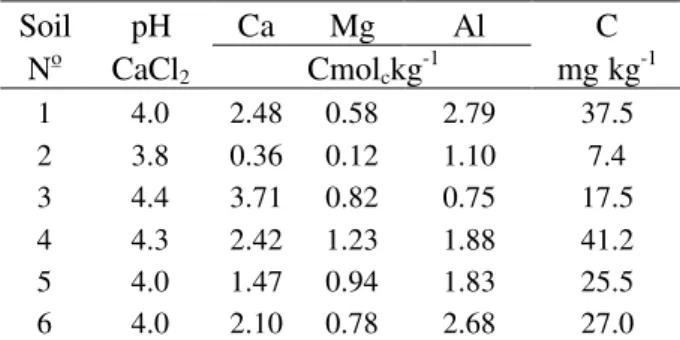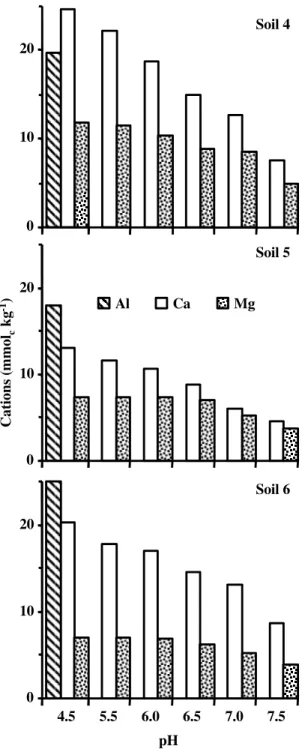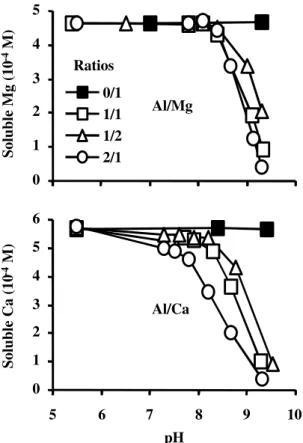Vol. 44, N. 2 : pp. 149 – 153, June, 2001
ISSN 1516-8913 Printed in Brazil BRAZILIAN ARCHIVES OF BIOLOGY AND TECHNOLOGY
A N I N T E R N A T I O N A L J O U R N A L
Reduction of Exchangeable Calcium and Magnesium in Soil
with Increasing pH
Mário Miyazawa, Marcos A. Pavan
*, Cláudio O. Ziglio and Júlio C. Franchini
Instituto Agronômico do Paraná (IAPAR). Caixa Postal 481, CEP 86001-970, Londrina - PR, Brasil
ABSTRACT
A laboratory study was conducted with soil samples and synthetic solutions to investigate possible mechanisms related with reduction in KCl exchangeable Ca and Mg with increasing pH. Increasing soil pH over 5.3 with CaCO3 added to the soil and with NaOH solution added to soil/KCl suspension increased adsorptions of Ca and Mg. The reduction of Mg was greater than Ca and was related to the concentration of soil exchangeable Al. The decreases of soluble Ca and Mg following addition of Al in synthetic solution were at pH > 7.5. The isomorphic coprecipitation reaction with Al compounds may be the most possible mechanism responsible for the decrease of exchangeable Ca and Mg with increasing pH. Possible chemical reactions are presented.
Key words: Coprecipitation, aluminum, liming, acid soils
*
Author for correspondence
INTRODUCTION
Soil acidity is of major concern in cropping, horticulture, and pasture production in Brazil. Lime applications have proved to be efficient in ameliorating soil acidity. However, high rates of
CaCO3, Ca(OH)2 or CaO caused reduction in soil
exchangeable Mg (Mgex) resulting in plant
nutritional unbalanced (Farina et al., 1980; Grove & Sumner, 1985; Myers et al., 1988). Laboratory studies conducted with soil column showed that
although additions of CaCO3 increased Mg
concentration in the drainage water, the total amount of Mg leached was less than the amount of Mg reduced in soil (Pavan et al., 1984; Pavan & Roth, 1992). Field studies in apple orchard showed that lime reduced leaf-Mg and fruit yields (Pavan,
1992, 1997). The reduction in Mgex has been
attributed to the exchangeable reaction between Ca
and Mg following by Mg leaching out of the root zone.
Kinniburgh et al. (1976), Chan et al. (1979), Grove et al. (1981), Grove & Sumner (1985), and Myers
et al. (1988) also found that lime reduced Mgex and
suggested that other mechanisms are involved in Mg reduction than a simple leaching process. They identified three possible mechanisms for the effect of lime on Mg reduction. In summary these include (1) Mg adsorption in the inter layers of
Al(OH)3 (Kinniburgh et al., 1976); (2)
coprecipitation of Mg as MgAl(OH)n (Kinnburgh
et al., 1976); and (3) adsorption of MgOH+ in the
stern layer (Chan et al., 1979).
The objective of this study was to determine the
possible mechanisms related to Mgex and Caex
MATERIAL AND METHODS
Three experiments were conducted with soil samples collected from the 0-20 cm horizon. The soil samples were air dried and ground to pass through a 2mm screen before being treated. Table 1 shows the chemical characteristics of the soils. Soils 1, 2, 3, 4, 5 and 6 were LEd, PV, LEd, TRd, LRd, and LRd, respectively, in according with brazilian soil classification.
Table 1 - Chemical characteristics of the soils.
Soil pH Ca Mg Al C
No CaCl2 Cmolckg-1 mg kg-1
1 4.0 2.48 0.58 2.79 37.5
2 3.8 0.36 0.12 1.10 7.4
3 4.4 3.71 0.82 0.75 17.5
4 4.3 2.42 1.23 1.88 41.2
5 4.0 1.47 0.94 1.83 25.5
6 4.0 2.10 0.78 2.68 27.0
Soil incubation with lime: Three soil samples
(soils1, 2, and 3, Table 1) were used for this study. One kg of soil sample was incubated in plastic bag
with CaCO3 for 120d, moistened to field capacity
(0.01MPa) at room temperature. Lime rates were 0.0, 0.25, 0.50, 1.0, and 2.0 times the amount of
total acidity (H + Al) extracted by 1 mol L-1
Ca(C2H3O2)2 at pH 7. Following incubation, soil
pH was measured in 0.01M CaCl2 (1:2.5
soil:solution ratio) after shaking for 1h; Caex, Mgex,
and Alex were extracted with 1 mol L-1 KCl
solution in a 1:10 soil:solution ratio and 10 minutes shaking time. Al was determined by
titration with standardized 0.015 mol L-1 NaOH
solution using bromotymol blue indicator and Ca and Mg determined by atomic absorption spectroscopy. The treatments were replicated three times in a completly randomized block design.
Addition of NaOH in KCl soil suspension: Three soil samples (soils 4, 5, and 6, Table 1) were used for this study. The procedure was as the following: 5g of soil sample was transferred to 100ml flask; 40ml of 1 mol
L-1 KCl solution was added; pH was adjusted daily
to 4, 5, 7, and 8 with NaOH solution for 7d.
with 1 mol L-1 KCl and pH, Ca, Mg, and Al were
determined in solution by the same procedures described above.
Effect of Al on Ca and Mg: Ten of 2 x 10-3 mol
L-1 Mg Cl2 solution was transferred to 60 ml glass
flask and added 10ml of 0, 1, 2, and 4 x 10-3 mol
L-1 AlCl3 solution. The solution pH was adjusted
daily to 4, 5, 6, 7, and 8 with NaOH solution for 3d. For adjusting pH, solution was shaked with
magnetic bars and boiled with N2 gas at a flow rate
of 100ml min-1 to avoid adsorption of atmospheric
CO2 by the solution. Then, the solution volume
was diluted to 40ml with deionized water and rested for 3d. Following resting period Mg was determined in solution by atomic adsorption spectroscopy. Similar study was conducted with 2
x 10-3 mol L-1 CaCl2 solution.
RESULTS
Soil incubation with lime: Table 2 shows the
effect of soil incubation with CaCO3 on pH, Caex,
Mgex, and Alex. Lime to pH > 5.8 reduced Mgex. At
pH near to neutrality, the reduction in Mgex was
93, 67, and 55% for soils 1, 2, and 3, respectively.
This reduction was related to the initial Alex
content (Table 1). The higher the Alex, the greater
the Mgex reduction. The reduction of Mgex at pH <
5.0 was minimal, corroborating data presented in previous study with Brazilian soils (Quaggio et al., 1982).
Increasing CaCO3 rates up to pH 4.9 increased
Caex (Table 2). The reduction in Caex increased
with increasing CaCO3 rates. For example, for 2.0
times H + Al rate, Caex, reduced to 55, 69, and
83% for soils 1, 2, and 3, respectively. At the
highest CaCO3 rate the reduction in Mgex was
Table 2 - Exchangeable Ca, Mg, and Al and pH after soil incubation with CaCO3
Soil pH Rates
CaCO3
Ca Mg Al
No CaCl2 %(H+Al) Cmolckg-1
1 4.0 0.0 2.48 0.58 2.79
4.5 25 6.78 0.61 0.85
4.9 50 10.21 0.53 0.08
5.8 100 16.25 0.32 0.0
7.1 200 21.45 0.04 0.0
2 3.9 0.0 0.36 0.12 1.10
4.3 25 1.77 0.12 0.40
4.8 50 3.15 0.12 0.04
6.0 100 5.53 0.08 0.0
7.0 200 7.77 0.04 0.00
3 4.1 0.0 3.71 0.82 0.75
4.4 25 5.94 0.83 0.16
4.9 50 7.87 0.81 0.0
5.9 100 12.11 0.74 0.0
7.2 200 18.32 0.36 0.00
Addition of NaOH in KCl soil suspension: Figure 1 shows the effect of pH on the concentration of Ca, Mg, and Al in KCl suspension for the three soils. Increasing pH decreased KCl exchangeable Mg. The reduction in KCl-Mg at pH 7.3 was an average of 49% for the three soils. Increasing pH also decreased KCl exchangeable Ca. The reduction in KCl-Ca was higher than in KCl-Mg. At pH 7.3 the reduction in KCl-Ca was an average 54% for the three soils. As expected, KCl exchangeable Al was undetected at
pH > 5.2.
Effect of Al on Ca and Mg: Figure 2 shows the
effect of Al and pH on the concentrations of
soluble Ca and Mg (Cas, Mgs). Aluminum started
to reduce Mgs at pH higher than 8.4. This pH
valuer agreed with that found in a solubility
diagram for the formation of MgAl(OH)n
presented by Hunsaker & Pratt
(1970). Increasing Al concentration at pH > 8.4
decreased drastically Mgs.
The behavior of Cas was similar than Mgs, except
for the pH which resulted in the beginning of Ca precipitation (Figure 2). Precipitation of Ca started
at pH 7.3. The reduction I n Cas was higher than
Mgs for similar pH and Al/M molar ration, were
M = Ca or Mg.
Cations
(mmol
c
kg
-1)
Soil 4
0 10 20
4.5 5.5 6.0 6.5 7.0 7.5 Soil 6
0 10 20
Soil 5
0 10 20
Al Ca Mg
pH
Figure 1 - Changes in KCl exchangeable Ca, Mg, and Al as function of pH
DISCUSSION
Calcium and magnesium are alkaline earth metals with d ifferent salt solubilities. In general, Ca-salts are less soluble that Mg-Ca-salts. For example
pKs for MgCO3 is 5.0; Mg(OH)2 is 10.7; MgSO4 is
soluble; CaCO3 is 8.32; Ca(OH)2 is 5.26 and
solution only at pH > 10.5 as Mg(OH)2 or at pH >
8.5 as MgCO3 (Lindsay, 1979).
Soluble Ca (10
-4 M)
0 1 2 3 4 5
Ratios 0/1 1/1 1/2 2/1
Al/Mg
0 1 2 3 4 5 6
5 6 7 8 9 10
Al/Ca
pH
Soluble Mg (10
-4 M)
Figure 2 - Effect of Al/Mg and Al/Ca molar ratios on soluble Ca and Mg with varying pH.
On the other hand, Ca precipitates as Ca(OH)2 at
pH > 12.5 or as CaCO3 at pH > 8.0 in an open
system (0.0003 atm of CO3). These pH values are
much higher than those found for the beginning of
Caex and Mgex reductions (Table 2 and Figure 1).
Therefore, the reductions in Caex and Mgex in the
present study were probably due to precipitation as
MgCO3 and CaCO3 or Mg(OH)2 and Ca(OH)2.
Both, Ca and Mg started to precipitate at a pH values where KCl exchangeable Al was absent (Table 2 and Figure 1). The concentration of a dissolved ion may decrease in solution due to the formation of a coprecipitate. In other words, during the formation of an insoluble compound, estrange ions may be incorporated in the precipitate (Ohlweiler, 1976). Two types of co-precipitate are characterized: (1) adsorption: estrange ions are adsorbed on the surface of the precipitate, which are easily removed from the solid surface by a simple water percolation, common in crystalline precipitate, and (2) isomorphic: estrange ions are incorporated in the precipitate structure, which are not easily removed
by solvents or other ions. This type of coprecipitation is common in amorphous precipitates, formed by metal hydroxides, such as
Al3+, Fe3+, Cr3+, Zn2+, and others (Ohlweiler,
1976). The solubility of Al in solution decreased with increasing pH (Table 2 and Figure 1). In the
pH range from 5.5 to 7.5, Al(OH)3 was the
principal specie (Baes & Mesmer, 1976). The soil
KCl exchangeable Caex and Mgex started to
precipitate at pH 5.2, while in pure solution, the precipitation started at pH 7.3 and 8.5 for Ca and Mg, respectively. These differences in pH which Ca and Mg started to precipitate is due to different
processes in the formation of Al(OH)3 amorphous
precipitate in soil and in pure solution.
A precipitate with net negative charge is probably
formed due to hydrolysis of the Alex with
increasing pH as shown by the following reaction:
(Soil-Al)2+ + 30H-↔ [Soil-Al(OH)3]
(1)
Reaction (1) favours adsorption of Ca, Mg, or
other metallic cation (M++) on the surface of the
precipitate. Therefore, isomorphic coprecipitate of Ca or Mg is formed in soil. Although Al in pure solution was also precipitated in the pH range from 5.5 to 7.5, Ca and Mg reductions were not detected (Figure 2). This result indicated that both cations did not form coprecipitate with amorphous
Al(OH)3 3H2O. The electrostatic attraction with
cations was extremely low due to the neutral charge of the Al amorphous precipitate.
Increasing pH > 7.5 species with net negative
charger are formed in solution, such as Al(OH)-4,
Al(OH)2-5, and Al(OH)3-6. These Al species
adsorb positive cations on the surface of the
precipitate reducing Cas and Mgs. The following
reactions are proposed for the reduction of Mg.
Al(OH)-4.2H2O + Mgs2+→ [MgAl (OH)4.2H2O]+ (2)
or
Al(OH)-4.2H2O + Mgs2+ →{Mg[Al(OH)-4.2H2O]2} (3)
Therefore, isomorphic coprecipitation reactions of Mg with Al-compounds are suggested to explain
the reduction of Mgex with increasing pH reported
for brazilian soils (Chaves et al., 1988; Pavan et al., 1984; Pavan & Roth, 1992). Similar reaction is believed to occur with Ca.
Other metals (Fe3+, Zn2+, Mg2+, and Cu2+) also may
suggested by Ohlweiler (1976). However, the concentrations of these metals in soil are so low that their contributions for Ca and Mg reductions are minimal.
CONCLUSION
The reductions of KCl exchangeable Ca and Mg with increasing pH were due to isomorphic coprecipitation with Al in soil as illustrate by the following reaction:
[Soil-Al3+.5H2O]2+ + 30H- ↔
[Soil-Al(OH)3.2H2O]
+ ½ M2+ ↔
[soil-Al(OH)3. ½ M.2H2O]
where M = Ca or Mg
RESUMO
Foram conduzidos experimentos de laboratório com amostras de solo e soluções sintéticas para investigar os possíveis mecanismos de reduções do Ca e Mg trocáveis com o aumento de pH. Os
aumentos no pH > 5,3 pelas adições de CaCO3 no
solo e NaOH na suspensão solo/KCl aumentaram as adsorções de Ca e Mg. A redução de Mg foi superior a de Ca, sendo relacionada com a concentração de Al trocável do solo. Em soluções sintéticas cotendo Al, as reduções de Ca e Mg
ocorreram em pH > 7,5. Atribuíram-se às reações
de coprecipitação isomórfica com compostos de Al, como o provável mecanismo de reduções de Ca e Mg com o aumento de pHs. São propostas as prováveis reações químicas responsáveis pelas reduções de Ca e Mg com o aumento de pH.
REFERENCES
Baes, C. F. and Mesmer, R. E. (1976), The hydrolysis of cations. New York, John Wiley and Sons. 489p Chan, K. Y.; Davey, B. G. and Geering, H. R. (1979),
Adsorption of Mg and Ca by a soil with variable charge. Soil Sci. Soc. Am. J., 43, 301-304
Chaves, J. C. D.; Pavan, M. A. and Miyazawa, M. (1988), Redução da acidez subsuperficial em coluna de solo. Pesq. agropec. bras., 23, 469-476
Farina, M. P. W.; Sumner, M. E.; Plank, C. O. and Letzsch, W. S. (1980), Effects of pH o soil magnesium and its absorption by corn. Commun. Soil Sci. Pl. Anal., 11, 981-992
Grove, J. H. and Sumner, M. E. (1985), Lime induced magnesium stress in corn: impact of magnesium and phosphorus availability. Soil Sci. Soc. Am. J., 49,
1192-1196
Grove, J. H.; Sumner, M. E. and Syers, J. K. (1981), Effect of lime on exchangeable magnesium in variable surface charge soils. Soil Sci. Soc. Am. J. 45, 497-500
Hunsaker, V. E. and Pratt, P. F. (1970), The formation of mixed magnesium-alumium hydroxides in soil materials. Soil Sci. Soc. Am. Proc. 34, 813-816 Kinniburgh, D. G.; Jackson, M. L. and Syers, J. K.
(1976), Adsorption of alkaline earth transition, and heavy metal cations by hydrous oxide gels of iron and aluminum Soil Sci. Soc. Am.J. , 40, 796-799
Lindsay, W. L. (1979), Chemical equilibria in soils. New York, John Wiley and Sons. 449p
Meites, L. (1963), Hand book of analytical chemistry. New York. McGraw.Hill, 1-49
Myers, J. H.; McLean, E. D. and Bingham, J. M. (1988), Reductions in exchangeable magnesium with liming of acid Ohio soils. Soil Sci. Soc. Am. J., 52,
131-136
Ohlweiler, O. H. (1976), Química analítica quantitativa. Rio de Janeiro, Livros Técnicos e Científicos, 365p Pavan, M. A. (1992), Manejo da calagem em pomares
estabelecidos de macieira. Pesq. agropec. bras., 27, 271-276
Pavan, M. A. (1997), Calcium sources for apple production in Paraná, Brasil. Ci. Cult., 49, 121-123 Pavan, M. A. and Roth, C. H. (1992), Effect of lime and
gypsum on chemical composition of runoff and leachate from samples of a brazilian oxisol. Ci. Cult.
44, 391-394.
Pavan, M. A.; Bingham, F. T. and Pratt, P. F. (1984), Redistribuition of exchangeable calcium, magensium, and aluminum following lime or gypsum applications to a brazilian oxisol. Soil. Sci. Soc. Am. J., 48, 33-38
Quaggio, I. A.; Mascarenhas, H. A. A. and Bataglia, O. C. (1982), Resposta da soja à aplicação de doses crescentes de calcário em Latossolo roxo distrófico de cerrado. II. Efeito residual. Rev. Bras. Ci. Solo, 6, 113-118


